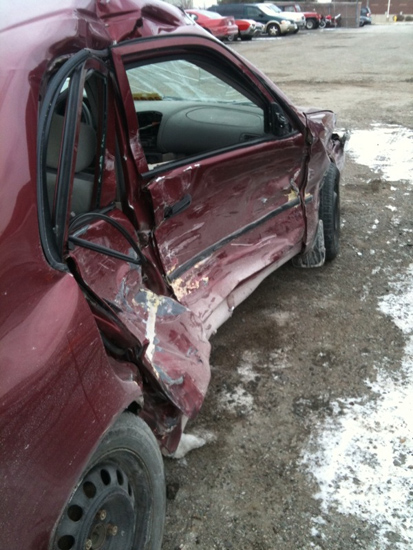
The man was driving his pickup that day, as I remember it, with his young daughter in the car seat beside him. Maybe he was in a hurry. Maybe he had too many things on the go. But – like too many of us – he decided to do some of his business while driving, on the phone. He happened to be driving along Brock Road in Pickering, Not., back in the days when the railway line below Taunton Road was a level crossing. He didn’t see the train in time and plowed into it. Bad enough, as I recall, he killed himself, but I remember the newspaper headline.
“Man drives truck into moving train,” it said. “Kills infant daughter.”
While the details were a bit foggy, I recalled the story (from maybe a decade ago) as I thought about making what I considered an important phone call while driving to the city this week. Even though I’ve got hands-free capability in my car, the recollection of that innocent kid paying the price of a father’s need to multi-task gave me pause. I considered how an inappropriate decision had cost that family dearly. Not to mention the trauma that first responders likely experienced when they arrived on the scene to deal with the death and destruction. Indeed, the CBC spoke to a retired B.C. firefighter, Tim Baillie, this week, about distracted driving.
“Ever since those damned (cell phones) came in, there’s been distractions,” Baillie told reporter Amber Hildebrandt. “You pick up bodies for 27 years, it pisses you off.”
It likely won’t placate firefighter Baillie, but this week his fellow law enforcers – Ontario provincial and municipal police – began levying stiffer fines ($280 up from $155) in an effort to curb the problem. It’s probably no surprise, but Canadian studies indicate up to 80 per cent of vehicle collisions in this country come as a result of inappropriate cell-phone use. Related fatalities are up 17 per cent (from 302 to 352 deaths) between the years 2006 and 2010. Police in Ontario hope a further penalty of assessing demerit points will help deter drivers even more. But according to the Insurance Bureau of Canada, hitting distracted drivers’ bank accounts may be the only way.
“Demerit points will certainly cause an insurer to look at a driver as a greater risk,” an IBC representative told the Toronto Star this week.
As I suggest, I support the idea of making distracted drivers feel like pariah. But – in our haste to reduce inappropriate cell-phone use – I do wonder about definitions here. I listened to a number of radio hosts this week going on about the police blitz and new fines. They wanted everybody to chime in on the issue. And, well, they did. What I heard were some intriguing contradictions about the definition of “distracted driving.”
It appears people are bothered that simply holding a cell phone constitutes “distracted driving,” while other activities do not. Among examples cited were: people who eat and drive, people who do their make-up and drive, people who scan the newspaper and drive. One person wondered why having a dog in one’s lap would not constitute “distracted driving” under the law, but simply having a cell phone lying between one’s legs would.
I have a vivid memory of the most extraordinary combination of distractions happening right in front of me. I was stopped at a light northbound on Kennedy Road (just below Hwy 401) and when the light turned green, a woman in the southbound left-turn lane did a complete u-turn in front of us northbound drivers. And as she wheeled her Mercedes across our lanes, I noticed she was also applying lip stick in mid-manoeuvre. Had I been the cop, I’d have charged her with three offences, none involving a cell phone, but all exhibiting forms of distracted driving.
I hasten to add the story I’ve repeated here a couple of times. En route home from Whitby a few days before New Year’s back in 2009, I was t-boned by a pickup truck that came through a red light and plowed into the right side of my Toyota. The driver, I learned from a witness, was on a cell phone, but because the grace period for warning drivers against such activity was still in effect, the driver managed to get off on a lesser charge. I still had to replace my car totaled by the collision. However, I counted my lucky stars that the pickup had hit the passenger’s side (where there was no one sitting), not the driver’s side.
So I think the increased fines and the potential for demerit points may be effective, but until distracted driving becomes as unacceptable as drunk driving or driving without a seatbelt, the legislators, the police and innocent victims will continue to lose out to multi-taskers who believe they’re not the problem.